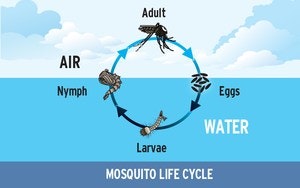The Life Cycle of a Mosquito - FULL LIFE CYCLE VIDEO #DumpandDrain

As we review the various stages of a mosquito’s life cycle, it is important to remember that there is a huge difference in the behavior between male and female mosquitoes. Female mosquitoes are the only ones that bite humans, animals, and mammals in order to draw blood to fertilize their eggs. When we think of mosquitoes as a Public...
As we review the various stages of a mosquito’s life cycle, it is important to remember that there is a huge difference in the behavior between male and female mosquitoes. Female mosquitoes are the only ones that bite humans, animals, and mammals in order to draw blood to fertilize their eggs. When we think of mosquitoes as a Public Health risk, we are focused on stopping the proliferation of female mosquitoes since they are the ones that carry and infect our community with mosquito-borne diseases.
Eggs
Mosquitoes generally lay 150-200 eggs at a time and are ready to hatch in as little as a few days given the proper conditions. All adult, female mosquitoes lay their eggs singularly in water but the eggs will display different characteristics and clumping tendencies based on the species of mosquito that lay them.
For example, the eggs of the invasive Aedes mosquito attach to one another, nose to tail, one by one. The eggs of the Aedes are also very hardy, complicating our eradication efforts; they can stick to the walls of a container like glue, live in saltwater, and can survive drying out for up to 8 months. The most common mosquitoes found here in the District are the Culex, whose females will lay their eggs twice over the course of their lifetime, which then clump into ‘eggrafts’ containing 150-200 eggs.
It takes 2-3 days for the eggs to hatch into larvae.
Larvae
Larvae emerge from mosquito eggs once they spend 2-3 days developing in water. Once hatched, all mosquito larvae must live in standing water, where they breathe and feed on microorganisms. After molting numerous times, larvae become pupae. This transformation from aquatic larvae to pupae takes about 2-3 days to complete.
This stage of the mosquito’s lifecycle is also the only time that chemicals can be used to target the mosquitoes.
Pupae
Pupae are essentially protective cocoons that exist in the water while mosquito larvae finish metamorphizing into adult flying mosquitoes. A pupa does not eat or breathe and only protects the mosquito emerging from the pupal skin until it leaves the water. This step also takes 2-3 days to occur.
Adults
After adult mosquitoes emerge from the pupae, male and female mosquitoes exhibit drastically different behavior. Male mosquitoes will locate the nearest tree or bush to feed on nectar from plant juices to sustain its body and life. On the other hand, female mosquitoes, also feeding on plant juices to sustain its life, will bite and feed on humans, animals, and other mammals for blood to fertilize their eggs.
The most typical meal for a female mosquito is a wild bird, which is also the main carrier and distributor of the West Nile virus, because they rest in the shade of trees and bushes where mosquitoes are located. After feeding, female mosquitoes will look for water sources to lay their eggs, thus continuing the lifecycle.
